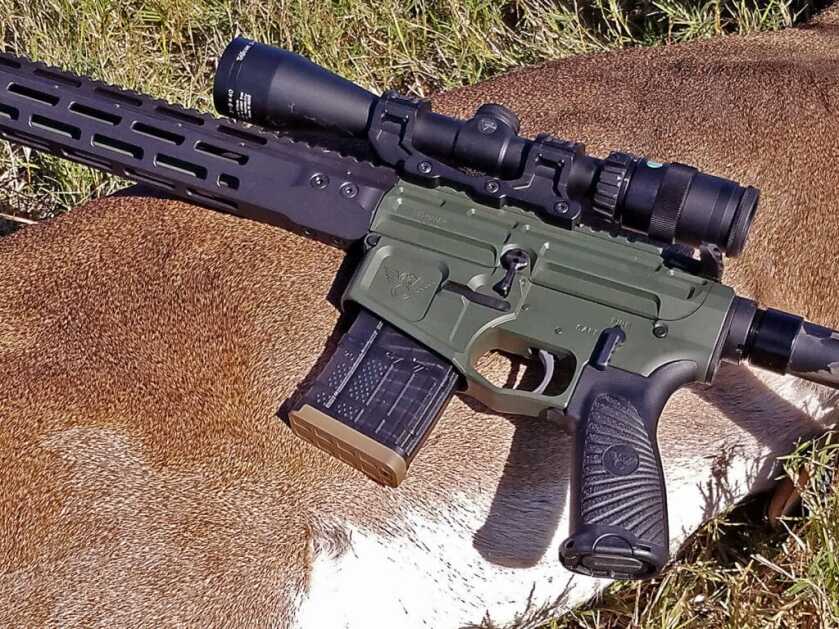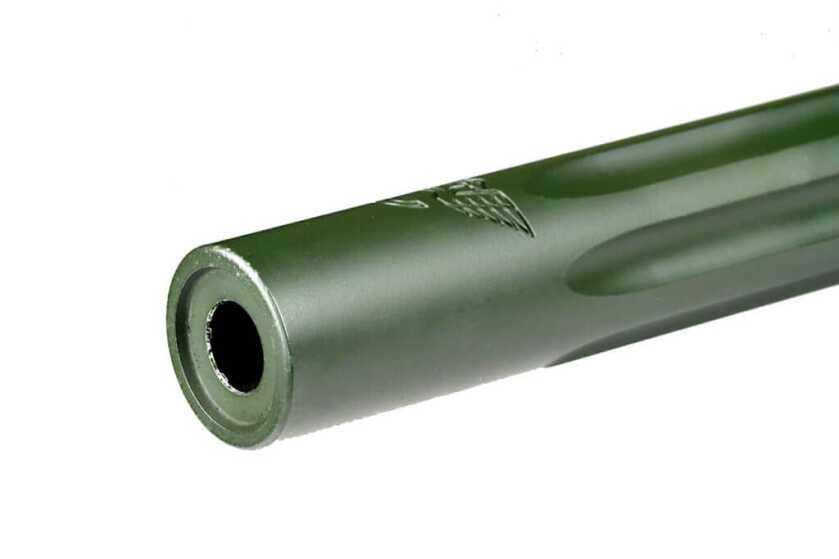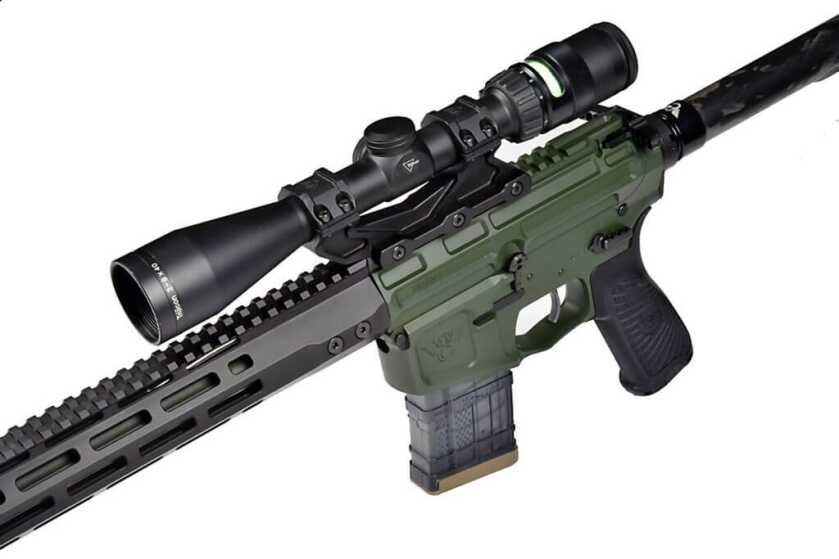
Weight and power.
Those have always been the primary factors limiting the utility of AR-platform guns for sporting use. Yes, you can shoot some potent cartridges from an AR-10 platform, but there’s generally a hefty weight penalty as the guns are considerably heavier than many of today’s lightweight bolt-action guns. An AR-15 can be made significantly lighter, of course, but just as the US military has found the 223/5.56 NATO cartridge to be lacking in some tactical situations, many people view the cartridge as marginal for deer-sized game — and it’s not even legal to hunt deer with in many states.
Bill Wilson, the respected lifelong competitive shooter, hunter, and owner of Wilson Combat firearms, set out to address that challenge a couple of years ago by developing a lightweight AR-15 that could do it all – from defending the castle to hunting medium-sized game – and do so with authority. The result was not only a new rifle weighing a bit less than seven pounds but a new cartridge that Wilson named the 300 HAM’R.

Wilson’s goal with the 300 HAM’R was to develop a round that could equal the terminal ballistics of the 30-30 Win., but have a much flatter trajectory by virtue of using high-ballistic-coefficient bullets. The design he came up with — a modification of his own 7.62x40WT cartridge — is based on a 223 Rem. case necked up to accept 30 caliber bullets, but with a 30-degree neck angle and a decreased case taper to maximize powder capacity. Out of a 16.25-inch barrel, the round launches a 125-grain bullet at a little more than 2,500 fps, compared to 2,175 fps for a 125-gr. 300 Blackout round and 2,365 fps for a 125-gr. 7.62×39 round. By virtually every standard of measurement, the 300 HAM’R dramatically outperforms comparable factory loads in either of those cartridges, particularly downrange. At 200 yards, the 300 HAM’R has 18 percent more retained velocity, 40 percent more energy and a 56 percent flatter trajectory than the 300 Blackout. Comparisons to the 30-30 Win. are equally instructive. Even out of a shorter barrel, the 300 HAM’R easily outruns and outpunches the 30-30 when you get much past 100 yards.
No matter how you slice the numbers, with same-weight bullets out of same-length barrels, the 300 HAM’R has greater velocity, less bullet drop and greater retained energy than comparable cartridges. In hunting, that translates into a cartridge you can have confidence in at 300 yards or less. In law enforcement and home-defense applications, it provides the ability to address threats with considerably more power and terminal effectiveness than a .223, but out of a platform that won’t weigh you down. In fact, all that’s required to convert an existing AR-15 to 300 HAM’R is a change of barrel. Wilson Combat sells barrels, complete uppers and complete rifles in several configurations for the 300 HAM’R.

If you’re worried about factory ammo availability, you shouldn’t be. Wilson Combat currently offers more than 20 different loads, in bullet weights ranging from 95 gr. to 150 gr. As this is written, a major ammo maker is expected to introduce a couple of loads in the near future, and another is taking a hard look at the cartridge. Wilson Combat also makes reloading data readily available.
The beauty of the cartridge design is that it is a perfect match to a handy, lightweight AR-15 platform, and Wilson Combat has put it all together in the Ultralight Hunter rifle.
Even at a glance, you’ll immediately notice that there’s no excess baggage aboard the rifle’s lightweight machined billet receivers. The upper is of the flattop variety, providing ample room for mounting optics. Like the receivers and other critical components, barrels are made in-house by Wilson Combat to exacting specifications to maximize accuracy and durability. The Ultralight Hunter has a fluted, button-rifled 16.25-inch match-grade barrel with a precision muzzle crown and a chamber and gas port optimized for reliability. It has a 1:15 twist for maximum accuracy with 110-gr. to 135-gr. bullets. The barrel on the basic rifle is not threaded, but you can order the gun with one that is. Both the receiver and barrel are protected with an Armor-Tuff finish. Green and black color schemes are standard, as is a non-threaded barrel, but other options are available.

Weight is further reduced with the use of a carbon fiber closed-shoulder-plate buttstock from Smoke Composites. The closed-shoulder-plate design helps prevent snags and even has a couple of M-LOK slots built in. Reliability is enhanced by the use of a standard buffer with a decidedly non-mil-spec 43-coil chrome silicon flat wire buffer spring, which is designed to undergo a very high number of compressions without progressively losing power like standard springs.
The rifle uses an intermediate-length gas system with an SLR Rifleworks adjustable gas block. It also has a low-mass, nickel boron bolt carrier group. This advanced finish provides the advantages of increased resistance to wear and corrosion and has a very low coefficient of friction, which translates into smooth cycling without the need to constantly add lubrication. In fact, during a prolonged shooting session at Bill Wilson’s ranch, where several writers burned through a lot of ammo while putting several rifles through their paces, I never saw a single malfunction and never saw anyone stop to lube the rifles.
Other components are of equally high quality. These include a small-latch BCM charging handle, a Mission First tactical pistol grip and a Wilson Combat 12.6 inch M-LOK rail with three three-section Magpul Type 1 rail covers to provide an enhanced gripping surface.

One of the things you’ll quickly notice about the rifle is the fact that it is equipped with an excellent trigger compared to those found on most other factory AR rifles. Wilson Combat calls it their M2 Tactical Trigger Unit and says it should have a pull weight of around 4 lbs. I was pleased to discover that the trigger on our test rifle broke consistently at a pull weight of 3 lbs. 5 oz. The two-stage trigger has a small amount of take-up before it stacks firmly, and then breaks crisply with a bit more pressure.
The rifle is guaranteed to shoot sub-MOA three-shot groups at 100 yards, and that’s what my test rifle did, but I kept shooting to see how the rifle performed with five-shot groups. I was not disappointed. Even though I generally prefer to use a higher-magnification scope than the Trijicon 3-9X40 scope provided for range testing, all three loads tested turned in average five-shot groups of just slightly over an inch, with two printing one-inch or less best groups. I consider that to be an excellent performance for such a light rifle with a relatively thin-contour barrel.

I wanted to further test the gun and cartridge in the field on a hog hunt near home in Texas with my pal Bryan Wilson of Frio County Hunts, but the hogs didn’t want to play the morning I had available to hunt. I did, however, harvest a whitetail deer for the freezer with a shot of just under 100 yards. Terminal performance was, as expected, impressive – and on par with anything I’ve ever shot with a 308 Win.
While the rifle proved to be at home in the field, I wouldn’t hesitate to use it in a home defense role, particularly when loaded with the right ammo. It’s worth noting that I didn’t see a lot of shift in point of impact with any of the three loads tested (including two 125-gr loads and one 130-gr. load), so keeping a spare magazine or two of your selected home defense ammo available may not handicap you in terms of switching from, say, a pure hunting round to a more desirable round for home defense if the bullets are close in weight. For the home-defense role, Bill Wilson recommends his load using a Speer 125gr TNT bullet. “It’s extremely accurate, creates a devastating wound channel and doesn’t over-penetrate,” he says.

If you want a rifle with the level of quality and performance this one provides, you’ll pay for it, as the Ultralight Hunter has a price tag of $3,295. But Wilson Combat isn’t known for doing things on the cheap. They’re known for doing things right and making guns that are superbly reliable and accurate. They’re known for making guns that you can bet your life on.
The Wilson Combat Ultralight Hunter breaks new ground while continuing this tradition.

Wilson Combat Ultralight Hunter 300 HAM’R
| Load | Avg. Velocity (feet per second | Avg. Group 100 yards | Best Group 100 yards |
| Wilson Combat 125 gr. PH | 2,502 | 1.02 | 1.00 |
| Wilson Combat 125 gr. TNT | 2,506 | 1.11 | 0.97 |
| Wilson Combat 130 gr. HP | 2,385 | 1.23 | 1.11 |
Note: Velocity was an average of 3 shots, measured with a Competitive Edge Dynamics M2 chronograph. Accuracy is taken from three 5-shot groups at 100 yards in wind varying 5-10 mph.
SPECIFICATIONS:
Caliber: 300 HAM’R, 1:15 twist
Action Type: Direct-impingement semi-auto
Trigger: Wilson Combat M2 two-stage
Barrel: 16.25-inch button-rifled match
Finish: Green/black Armor-Tuff
Stock: Smoke composite carbon fiber
Overall Length: 35.5 inches
Weight: 7 pounds
MSRP: $3,295
URL: www.wilsoncombnat.com
CONTACTS:
EXTRA PHOTOS:








Reading the comment section, I find it kind of annoying that people act like every article written should be about guns in the “average guy” price range. Sometimes it’s nice to read about the expensive guns and dream. If you can’t afford it, then don’t buy it, but the world doesn’t revolve and YOU, and YOU don’t set the price range for what gunmakers make, and what writers write about.
Me personally, I thought WC guns were too expensive until I shot one. Out of the box with an average scope the .308 averaged 1/2 inch groups at 100 yards. That’s 0.5 MOA. With Federal Ammo. The fit and finish is perfection, and working the action, it’s as smooth as the skin on a well-oiled stripper. Now I own 3 WC ARs and 1 handgun. Expensive, yes. For me, it’s worth it. For you, that’s for you to decide.
Very nice rifle but no price……
$3295.00 maroon it said this twice in ad
Moron is spelled moron…..not maroon. And yes……the price was mentioned twice an he is a moron……..
“And” is spelled “and”, not “an”. Should’ve just kept your mouth shut.
“And” he very well could have been channeling bugs bunny, who I clearly remember used maroon instead of moron.
You don’t have to be a total ass about it… Wait, I know… It just comes naturally to you.
Being a moron calling someone else a “maroon”. Although I have heard people intentionally substitute maroon for molon, I do not think that that was your intention.
And I STRONGLY suggest to all that using that term is VERY wrong. It’s VERY racist, look it up.
dont know why you writers are so over board with the 300 hamr??
the Czech’s did it in 1952. look up the Czech 7.62X45 you’ll be surprised,
having a VZ-52 rifle i know what it can do. 122-124gr bullets easily to 2650+ FPS
and under an 1-1/2″ at 100 yards and i didn’t have to sell the farm to do it.
all the hard work was already done wilson.
[img]https://i.imgur.com/ivnKqbKl.jpg[/img]
Uh, no they didn’t. A 9.1lb wooden stocked rifle, firing a cartridge that will NOT fit in the AR15 platform, that takes up powder capacity due to bullet seating depth, using a barrel 20% longer but at the same FPS, and a bullet a whopping 4% heavier, does not compare favorably to the Ham’r, saying nothing of being chambered in an obscure, obsolete caliber and rifle.
I’m particularly interested in the 458 HAMR. Does everything a 458 SOCOM can do and then past 140 yards the HAMR still has the velocity for bullet expansion out to 300 yards. Fills the void that 458 SOCOM left.
In one breath you say that the 300HMR outperforms the 30-30 and then you say that it would make a good house gun?! A 30/30 round does NOT make a good house gun! By giving this rifle a 1in 15 twist, you cannot make the 300HMR sub-sonic because the twist rate is too slow so it fails the comparison to the 300 BO!
BTW, a 300 BO makes a good house gun! Also, you can get hot loaded 30-30 factory ammo that is in the 308 WIN class! The 300HMR can never do that! To add, the rifle is WAY overpriced!
I don’t know if 300 BO is a good house gun, but it’s a terrible hunting round. If you’re primary focus is quiet, then it’s a great round, but for effectiveness, not so great. Average at best.
The 300 HAMR is n’t designed for subsonic, it’s designed to be a .30-caliber hunting cartridge out of a standard size AR. Along the same line of thinking as the .30 Rem AR, which was a great round, but failed to be marketed properly.
I would not hunt with a 300 BO. I would, and DO hunt with a .300 HAMR. I would love to see companies like Palmetto State Armory jump on board and make uppers for it, then it will become more popular.
“Also, you can get hot loaded 30-30 factory ammo that is in the 308 WIN class! The 300HMR can never do that! ”
Really? Cite some 30-30 130gr loads that exceed that of the Ham’r with the same barrel length.
Because I can find a ton of published 30-30 130gr loads won’t achieve the same velocity in 24″ barrels that the Ham’r will in a 16″ barrel. At best they can equal it. With an additional 8″ of barrel. Not impressive.
Wildcat rounds are a lot of fun, but I don’t see this one hitting mainstream. Not when you can put together a .300 Blackout or a 350 Legend for under $300 using your own existing lower. Plus, the cost of ammo is also a factor. If I can buy practice rounds at $10/20 (Winchester white box 350 Legend), then I’ll be able to shoot more and have even more fun. Face it, your average Joe working his ass off to pay his bills and keep food on the table, won’t be buying a $3k AR-15.
However; to make this round successful, get a factory onboard to bring the cost of the ammo to around .50 cents a round, that someone can pick up off the shelf as well, then you’ll be making progress. From that price point, work up precision hunting rounds at higher cost and as the round becomes more popular, the more likely average folks will adopt it. Compare and contrast the success of the .300 Blackout vs. the .300 Whisper. Nobody even talks about the .300 Whisper anymore.
Cuz it’s the same cartridge 🤫
Sure, now I suppose you’re going to tell me the .300 AAC is also the same caliber, too! 🤣
An AR for home defense, I am guessing you have had no law enforcement training. If you had Your 1st question SHOULD BE what is behind the person you shooting at. One time in California we had a shooting where the homeowner was 00 Buck, we found a pellet in the fender of a VW four houses down the street.
“I am guessing you have had no law enforcement training”
Is that where you learn to achieve between 9 and 51% hits, as well as shooting pets and innocent bystanders?
I can, however, point to numerous SUCCESSFUL home defense situations where an AR or similar high capacity, semi-automatic rifles were used to great effect.
6.5 Grendel is a very under-rated round and is used in an AR-15 platform. Same concept but WAY cheaper! The energy and trajectory is very impressive and some say comparable to the .308. Mine weighs in around 7 lbs with a 20″ barrel empty and without scope.
I agree. .300 HAM’R is another unneeded rifle cartridge. If I wanted an AR-15 I would go with .300 AAC Blackout, 7.62 x 39, 6.5 x 39 Grendel, or 6.8 x 43 Special Purpose Cartridge.
Grendels do not work with a standard AR bolt nor magazines. Same with 7.62×39. Next.
Sorry, but the comparison isn’t all that valid against the .300 Blackout UNLESS tested as a subsonic round too. After all, that was the real idea behind the Blackout.
I see that the HAM’R maximizes the original AR Platform, but at what cost for it’s original intended use?
And is that cost worth it IF it’s subsonic performance doesn’t match up?
The 300 BLK Out with heavy subsonic ammo for hunting is seariously lacking. The big overly stabilized bullets just pencil on through without doing much damage. So the comparison of the two for hunting included the 125gn bullets that are suited for hunting deer and Boar. In this case the 300 Hamr wins hands down.
.300 HAM’R is a very rare and uncommon rifle cartridge. I would take .300 AAC Blackout or 7.62 x 39 any day over this new rifle round that will likely be forgotten very soon.
It’s rare because its new, and it fills a niche.
300BLK in the supersonic role, in long barrels, is a waste. After 8-10″, the gains are almost nil. In factory supersonic ammo, 16″ barrels, Ham’r absolutely spanks the 300BLK.
Subs are a different story, but that is not what the Ham’r was designed for either.
FWIW, I own and hunt with an 8.5″ 300BLK pistol, so it’s not like I haven’t dug into the numbers.
Sorry, but bullet construction is EVERYTHING when hunting, and you are speaking of “overstabilization” like it’s a military round, and tied into terminal performance characteristics.
Frankly, the two, while not mutually exclusive, are not THAT tied into each other.
You are speaking of two SEPERATE performance criteria, and overstabilization has little to do with terminal performance such as ‘mushrooming’. Now if you spoke to velocity and energy, then yes, but exterior ballistics are not an indicator of terminal bullet performance, such as “pencil on through”.
This is a case of matching bullets to the criteria of usage.
This looks to be a wonderful rifle, but very few hunters/shooters would even read the article if the cost of the baseline economy version was sitting at $3350+ with shipping, transfer fee, sales tax, and whatever else the state feels is necessary. How about testing something in the Aero Precision price range?
That all sound great, but unless the round is a great commercial and military success, I think it’ll go the way of the .45 G.A.P. The G.A.P. is great round in and of it’s self. but it just couldn’t get enough momentum behind it, for it to be a commercial success.
Agreed! The 45gap is more of a 380 compared too the 9mm. Reloading one’s own would be the cost effective way for sure! A 7lb ultralite weighs more than S%W, but the barrel on the Wilson is heavy and probably adds 1.5lbs extra weight? Someone wants an AERO PRECISION comparison, well I have 1! I enjoy fanatically my AP without a doubt! I built it with their parts with a few exceptions (trigger, safety, handgrip and buttstock) some of which are magpul on their builds. Now forget the cost and look at design! His purpose was too make a faster cartridge with up too 130gr bullets. Nicely done! I myself mostly load(reload) up to 135gr, but I’m doing this for my 8.5″ AP barrels. Up too 300 yards for my limit. I do it for light and fast instead of slow and heavy! Everyone has their options/choices, so good range day/hunting too all!